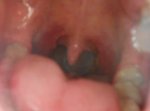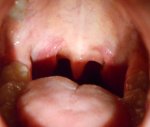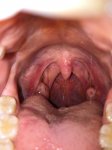Hip
Senior Member
- Messages
- 18,301
@skatardrummer
What you have your throat certainly looks like a classic example of crimson crescents, which are found in the majority of ME/CFS patients.
Cunha 1992 found crimson crescents in 80% of ME/CFS patients, but less that 5% of people with sore throats had these crescents. Someone here said crimson crescents are also present in Lyme disease, mononucleosis and lupus, but does not provide any source for his statement.
The poll attached to this thread found 87% of forum members responding to it had crimson crescents.
Cunha suggests that crimson crescents are a useful tool to aid diagnosis of ME/CFS. Though normally ME/CFS diagnosis is performed using criteria such as the CDC Criteria for ME/CFS, or the Canadian Consensus Criteria.
Note that anemia can cause symptoms similar to ME/CFS, so I would wait until you have your anemia sorted out before you jump to any concussions about having ME/CFS. In fact in the Canadian Consensus Criteria, anemia is specifically mentioned is something that would exclude you from an ME/CFS diagnosis (until your anemia is fixed).
An article on the crimson crescents found by Burke Cunha:
What you have your throat certainly looks like a classic example of crimson crescents, which are found in the majority of ME/CFS patients.
Cunha 1992 found crimson crescents in 80% of ME/CFS patients, but less that 5% of people with sore throats had these crescents. Someone here said crimson crescents are also present in Lyme disease, mononucleosis and lupus, but does not provide any source for his statement.
The poll attached to this thread found 87% of forum members responding to it had crimson crescents.
Cunha suggests that crimson crescents are a useful tool to aid diagnosis of ME/CFS. Though normally ME/CFS diagnosis is performed using criteria such as the CDC Criteria for ME/CFS, or the Canadian Consensus Criteria.
Note that anemia can cause symptoms similar to ME/CFS, so I would wait until you have your anemia sorted out before you jump to any concussions about having ME/CFS. In fact in the Canadian Consensus Criteria, anemia is specifically mentioned is something that would exclude you from an ME/CFS diagnosis (until your anemia is fixed).
An article on the crimson crescents found by Burke Cunha:
Crimson Crescents Facilitate CFS Diagnosis
By Robert B. Marchesani
Infectious Disease News, November 1992
MINEOLA, NY—A new physical finding in chronic fatigue syndrome patients may finally give clinicians what they have only dreamed about a clinical way to diagnose the disease.
Burke A. Cunha, MD, discovered what he called crimson crescents in the mouths of 80% of his CFS patients. After the word got out, Cunha received calls from other parts of the country. Physicians began telling him that they also were finding the crimson crescents in their patients once they looked for them.
"When we look inside somebody's mouth, infectious disease doctors and internists instinctively go right to the back and look at the pharynx. When they do that, they miss these crimson crescents because they are on the side. People have missed them for years," said Cunha, MD, chief, infectious disease division, Winthrop-University Hospital, Mineola, N.Y.
For the first time physicians may have a specific indicator to look for on physical examination of chronic fatigue syndrome patients, not unlike the bull's eye of erythema chronicum migrans in Lyme disease patients.
"If your patient has crimson crescents, you now can say it is probably chronic fatigue syndrome," Cunha said.
Cunha' s crimson crescents are located on both sides adjacent to the back molars. (See figure.) They are present as a crescentic membrane of tissue that points toward the uvula. During a tonsillectomy that membrane is removed, which is the anterior pharyngealpillar. This area is crimson-purple and looks like a crescent moon chopped in half because the base goes into the tongue. The top of the crescent bows in toward the middle such that each side mirrors the other, Cunha explained.
When someone has a tonsillectomy, the borders of the crescent become less distinct and the margins are not as sharp. They are located posteriorly where the tonsil would have been before it was taken out. So even patients who had their tonsils removed still present with the crescents but the location and appearance are modified, according to Cunha.
They are always bilateral, and they can be very bright, which is why he called them crimson instead of purple. These crescents last for months and gradually fade as the disease goes into remission. When the patient gets sick again, the crescents usually get redder.
"In chronic fatigue you always find the crescents alone. The rest of the pharynx is uninvolved," he said. There is a small portion of the normal population that may also present with these crescents. "If you get a patient with a sore throat in the office, he or she can have crimson crescents, and the back of the throat is red," Cunha said.
Cunha found crimson crescents in 3% to 5% of non-chronic fatigue patients who presented with non-specific sore throats. Patients who present with mononucleosis or Group A strep do not have the crescents, nor do those with cytomegalovirus pharyngitis or the common viral pharyngitis, according to Cunha.
After seeing many patients in a chronic fatigue study center at Winthrop Hospital, Cunha has his own beliefs about the etiology of CFS. "I believe that the virus that causes chronic fatigue comes from young adults or children who give it to adults. The young child recovers from the illness but the young adult gets a sore throat and some go on to develop the chronic fatigue in adults. I do not know why, but that intrigues me," said Cunha who is also professor of medicine at the State University of New York at Stony Brook Health Sciences Center School of Medicine.
Cunha is trying to grow virus out of these crescents in an attempt to discover their cause. "The problem is when anyone does antiviral throat cultures, clinical labs are not equipped to grow HHV-6. In addition, with viruses you have to go deeper than just the surface because they live within cells. So my next step is to biopsy the crescents," Cunha said. Since there is no test for CFS, the physician must infer the disease from other sources.
"But the most consistent lab evidence that we look for are elevations of coxsackie B-titers and elevations of HHV-6 titers in combination with the decrease in the percentage of natural killer T cells," Cunha explained.
"If the patient has two or three of these abnormalities in our study center, then he or she fits the laboratory criteria for chronic fatigue. Nearly all patients with crimson crescents have two out of three of these laboratory abnormalities," he said.
Cunha's finding is especially promising for physicians who practice too far from a lab to get such evidence. "If you are a physician out in the middle of nowhere and you can't get HHV-6 titers and you can't get the natural killer-cell percentage, then the crimson crescents may be the only way besides history that can suggest the diagnosis," Cunha told Infectious Disease News.
This article was reprinted by The CFIDS Association of America, Inc. publisher of The CFIDS Chronicle 800/44-CFIDS by permission of Infectious Disease News. Volume 5, Number 11, November 1992.
Source: http://www.immunesupport.com/93sum007.htm




